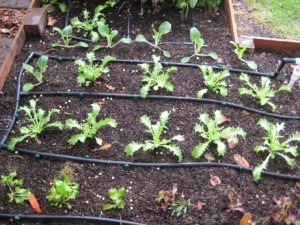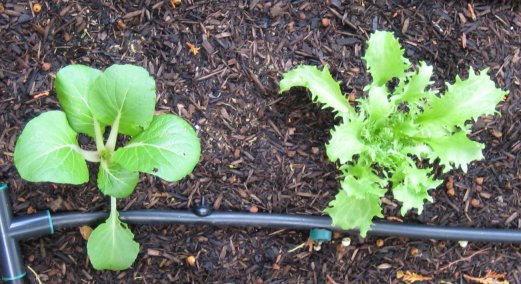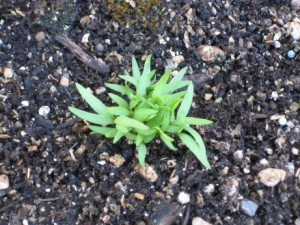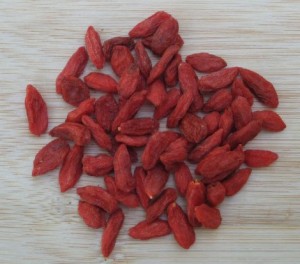Here in northern California, many different types of foods can grow throughout the fall, winter, and spring, especially greens. Right now, some of our summer crops are still producing, such as heirloom tomatoes, bell peppers, and summer squash, which are doing well despite the rain and cool night temperatures we have been experiencing lately. We do have space in our garden for fall plants, so last week, I went to a local farmer’s market, and purchased some plant starts, including red and green leaf lettuce, bok choy, and frisée greens. Here is a picture of these plants now growing in our garden:
This Sunday, we returned from a weekend out of town teaching our Science of Raw Food Nutrition I class (it was fun, as always!) to find that our starts had almost doubled in size! Right now, it appears that the frisée greens have the lead over the bok choy and lettuce, but later in the season we will see which of our greens will be the ultimate champion size-wise.
Nutritionally speaking, all of these plants have their attributes. Bok choy is often praised for its mineral content, but what about much less heard-of frisée greens?
Here are some nutrient highlights of frisée greens:
| 3 cups chopped frisée greens (150 g) | Adult Daily Values | |
| Calories | 25.5 | |
| Calcium | 78 mg | 1000 – 1200 mg |
| Iron | 1.24 mg | 8 – 18 mg |
| Zinc | 1.18 mg | 8 – 11 mg |
Young bok choy and frisée greens:
One of the best ways to keep in touch with us is to join our email list. You’ll receive a free copy of Our Top 12 Strategies for Long Term Success on A Raw Plant-Based Diet eBook along with regular information about raw food and plant-based diets and periodic promotions for our classes, events, and other offerings!
Growing goji berry plants – Update
Rick and I returned home from a long weekend out of town to find that our goji seeds had germinated! We are so excited! Here is a photo of two growing together.
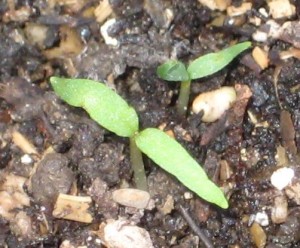
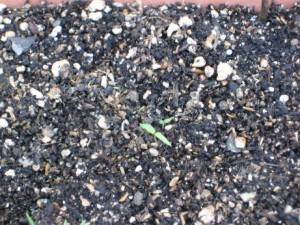
Here is a group of very young goji plants growing together. I planted a whole berry here and it appears that many of the goji seeds germinated.
Our next task is to thin the plants so each can have more space to grow. We’ll keep you updated on their progress. 🙂
One of the best ways to keep in touch with us is to join our email list. You’ll receive a free copy of Our Top 12 Strategies for Long Term Success on A Raw Plant-Based Diet eBook along with regular information about raw food and plant-based diets and periodic promotions for our classes, events, and other offerings!
Growing goji berry plants
At the time, I had never before seen an actual goji plant growing in a garden, given that goji berries are native to Asia and are not popularly cultivated as a garden crop here in the United States. Not surprisingly, the berries on the plant reminded me of tiny Roma tomatoes, given that goji berries (lycium barbarum) are in the nightshade plant family (Solanaceae), the same plant family as tomatoes, potatoes, bell peppers, eggplant, and Incan berries (a.k.a. golden berries).
I was excited to find after doing a little research that goji plants can grow in the area where Rick and I live. I am a big fan of locally grown food, so I thought it would be fun to grow some goji berry plants in my backyard garden.
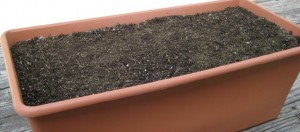
Today, I looked for a suitable container in which to grow my goji seeds. I found an unused planter, filled it with soil, and made ½ inch deep holes about 2 inches apart. I opened several goji berries to find 20+ tiny seeds in each, which I carefully removed and did my best to place one seed in each of the holes. In several of the holes, I placed a single goji berry to see if multiple seeds would germinate together. I filled in the holes with soil and then watered the planted seeds and soil.
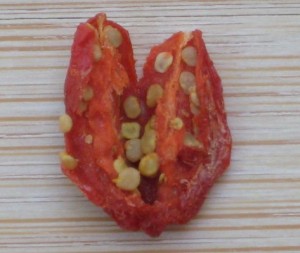
Now that the seeds are planted, I am looking forward to seeing how many, if any, actually germinate and produce plants. I’ll give you updates as the growing season progresses. 🙂

